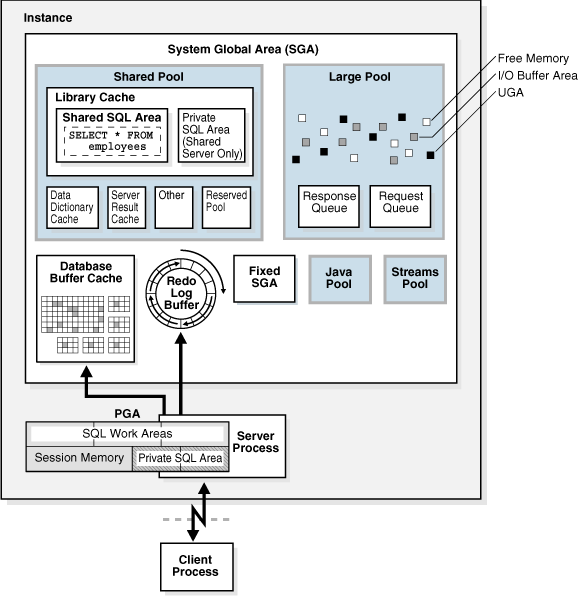Memory Architecture
Oracle Database utilizes various memory structures to manage and store essential data and information for efficient operation. These memory structures can be categorized into the following:
- System Global Area (SGA): The SGA is a shared memory area that contains critical data and control information for an Oracle Database instance. It is shared among all server and background processes. Key contents of the SGA include cached data blocks and shared SQL areas.
- Program Global Area (PGA): The PGA is a nonshared memory region dedicated to each individual Oracle process. It contains data and control information specific to that process. There is one PGA for every server and background process. The total collection of individual PGAs is referred to as the instance PGA, and its size is determined by database initialization parameters.
- User Global Area (UGA): The UGA is memory associated with a user session. It contains data relevant to the user’s session, such as session-specific information.
- Software Code Areas: These memory segments store the Oracle Database code, which is separated from user programs. This isolation ensures that Oracle Database code is stored in a more protected location.

Memory management in Oracle Database is crucial for optimizing the sizes of these memory structures as the database’s demands change. Oracle Database achieves memory management through various methods:
- Automatic Memory Management: In this mode, you set a target size for the entire database instance memory. The database instance then automatically adjusts memory allocation between the SGA and instance PGA as needed to meet the target.
- Automatic Shared Memory Management: This approach automates part of memory management. You set a target size for the SGA and have the option to set an aggregate target size for the PGA or manage individual PGA work areas.
- Manual Memory Management: Instead of setting a total memory size, you configure various initialization parameters to manage SGA and PGA components separately.
The choice of memory management method depends on your specific database configuration and requirements. For instance, if you use the Database Configuration Assistant (DBCA) and select the basic installation option, automatic memory management is typically the default setting.
In summary, Oracle Database relies on different memory structures, including the SGA, PGA, UGA, and software code areas, to store and manage crucial data and control information. Memory management options include automatic memory management, automatic shared memory management, and manual memory management, allowing you to tailor memory usage to your database’s needs.

No Comments